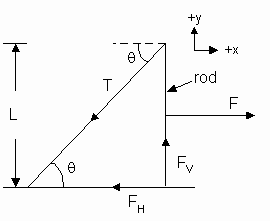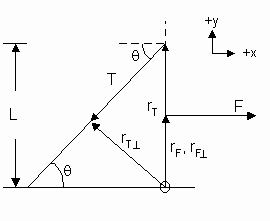Guide 11-2. Solving Static Equilibrium Problems
|
There are many examples in section 11.3. As an additional example, we'll do problem 30 on page 352.
 Problem:
A rigid, vertical rod of negligible mass is connected to the floor by an
axle through its lower end. The rod also has a wire connected between
its top end and the floor. If a horizontal force F is applied at the
midpoint of the rod, find a) the tension in the wire, and b) the horizontal
and vertical components of force exerted by the bolt on the rod.
Problem:
A rigid, vertical rod of negligible mass is connected to the floor by an
axle through its lower end. The rod also has a wire connected between
its top end and the floor. If a horizontal force F is applied at the
midpoint of the rod, find a) the tension in the wire, and b) the horizontal
and vertical components of force exerted by the bolt on the rod.
Let's look at the net force problem first. The situation is diagramed to the right. Unlike net force problems that we've done in the past, note that the forces are drawn from their points of application on the rod. This will be important when we do the net torque part of the problem later.
Open this animation to see how the forces change as F increases.
The net force equations are:

 We'll
come back to these equations later when we need them. Let's look at
the net torque problem next. We need to select an axis of rotation.
If we select it at the point where FV and FH act, then
those forces will contribute 0 torque. With that choice, the moment
arms of F and T are shown to the right.
We'll
come back to these equations later when we need them. Let's look at
the net torque problem next. We need to select an axis of rotation.
If we select it at the point where FV and FH act, then
those forces will contribute 0 torque. With that choice, the moment
arms of F and T are shown to the right.
The position vector of F coincides with its moment arm, which equals L/2.
Note that the angle from the position vector, rT, to T is θ + 90°. Then
![]() .
.
The net torque equation is:

Solving for T,
![]()
Substituting this expression for T back into the Fnet,y equation and simplifying gives us Fv.

Substituting T into the Fnet,x equation and simplifying gives FH.

As a check on our results, examine T. The horizontal component of T is ½F. This is equal to FH. That makes sense, because equal horizontal forces of ½F on each end of the rod would not only balance F but would also keep the rod from rotating. As another check, note that the downward component of the tension force is Fsinθ /(2cosθ) = ½Ftanθ. This is equal in magnitude to FV as is necessary for the vertical forces to be balanced.
Let's look at the equilibrium of torques problem using a different axis of rotation to show that the results are the same. Let the axis of rotation be the point of application of force, F. We won't redraw the diagram, but note the following.
- The torque of F is 0.
- The torque of FV is 0, because it's line of action passes through the axis of rotation.
Thus, the non-zero torques are those due to T and FH. The horizontal component of T is the only component that will contribute to the torque about the chosen axis of rotation. Tx and FH have equal moment arms of L/2 about that axis. Since they must produce equal and opposite torques, they must have equal magnitudes. Since their sum must equal F, Tx = FH = ½F. From this point, T and FV can be found.
See this additional example. This is problem 11-24 of the text with a modification in the goal.
© North Carolina School of Science and Mathematics, All Rights Reserved. These materials may not be reproduced without permission of NCSSM.